The needle is back.
It’s okay to shudder. We’re rapidly approaching the first major election since American media largely flopped (The New York Times’ election-night needle included) in adequately reporting on the 2016 race and forecasting a Trump presidency.National elections are, alongside the Olympics, the premier staging ground for American media experiments with technology and formats. (Both are really big events, scheduled years ahead of time, that produce a ton of real-time data to crunch and present.) The midterms are an opportunity to test what works — and what flops — halfway through Trump’s first term, with (hopefully) a substantial swath of America heading to the polls November 6 to vote for governors, senators, congresspeople, and various other local officials.
Innovative coverage of the 2016 election featured Slack tools, podcasts, and even a quasi-time capsule. But those are so 2016.
In this election cycle, news organizations are leaning on email newsletters to explain the first nationwide Election Day since “President Trump” became a reality, as well as on text-in-your-question experiments and collaborative efforts like Electionland 2.0.
Here are some of the approaches news organizations are using to push smart info on the campaigns and Election Day this time around, with some local ideas sprinkled in for good measure. (We’re not perfect and didn’t get everything — but we’re also not going to include everything. If you think your project merits inclusion, email me at christine@niemanlab.org.)
Prepare to destroy your inbox — with good political content. The New York Times and The Washington Post each launched newsletters behind various faces of the organizations to decode the day-to-day of the races.
The Post’s national political correspondent David Weigel has been sending out a thrice-weekly newsletter from the campaign trail called The Trailer. “If there’s one theme to this newsletter, it’s this: The campaign you see on TV and Twitter is not the one being run in the states,” he wrote in one issue datelined Millersburg, Ohio. “More than ever, the drama of national politics is diverging from the parties’ messaging from race to race, and district to district.” The Trailer includes a lengthy intro analysis and special sections highlighting political ads, polls, the impact for 2020, and my favorite: “Meet a PAC.”
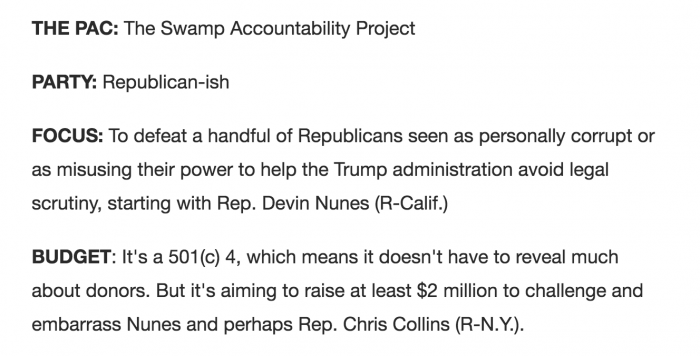
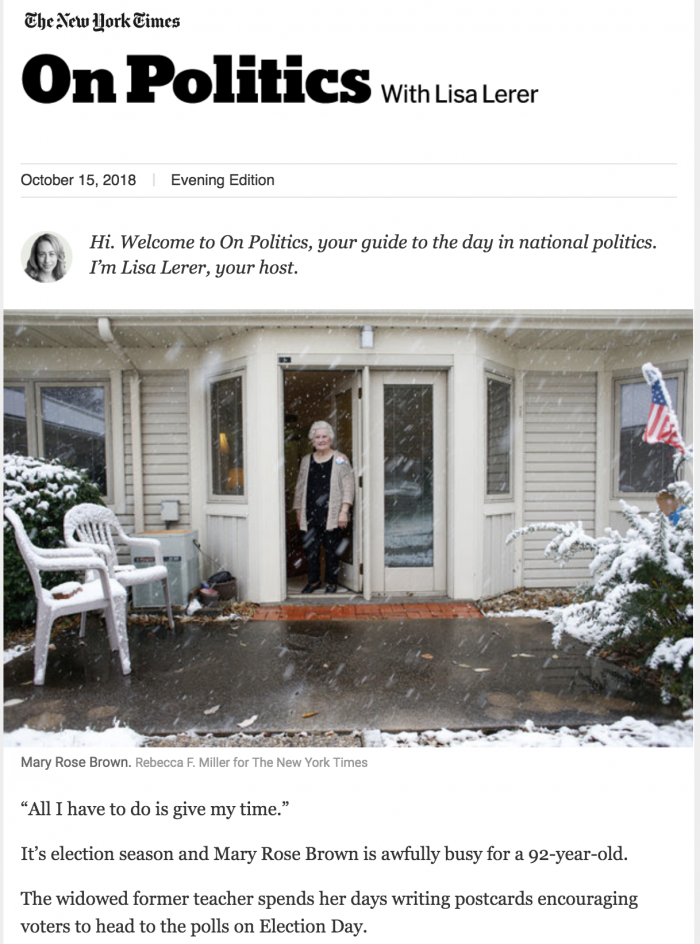
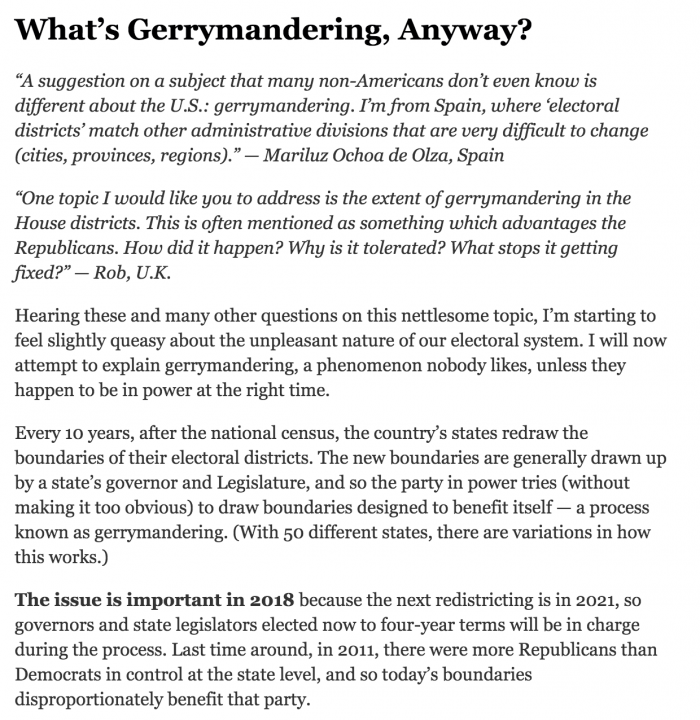
Since your email inbox is already swimming in midterms coverage, you might as well add to your messages inbox. (Reminder: Editorial emails can generate low-to-middling open rates, but nearly all SMS messages are opened. Another reminder: SMS messages are not/should not be treated the same as emails! Sacred space, intimate communications, etc.)
The Lenfest Local Lab and the Philadelphia Inquirer’s innovation desk, respectively spearheaded by the now-sunset Guardian Mobile Innovation Lab‘s co-leader Sarah Schmalbach and Inquirer audience and innovation managing editor Kim Fox, built a texting product via GroundSource for The Inquirer’s Jonathan Lai to break down campaign issues with residents. Participants opt in for daily texts related to New Jersey or Pennsylvania elections (since Philly rides the Pennsylvania border) that share context about an issue like gun control in the New Jersey Senate race and link to an article with more details.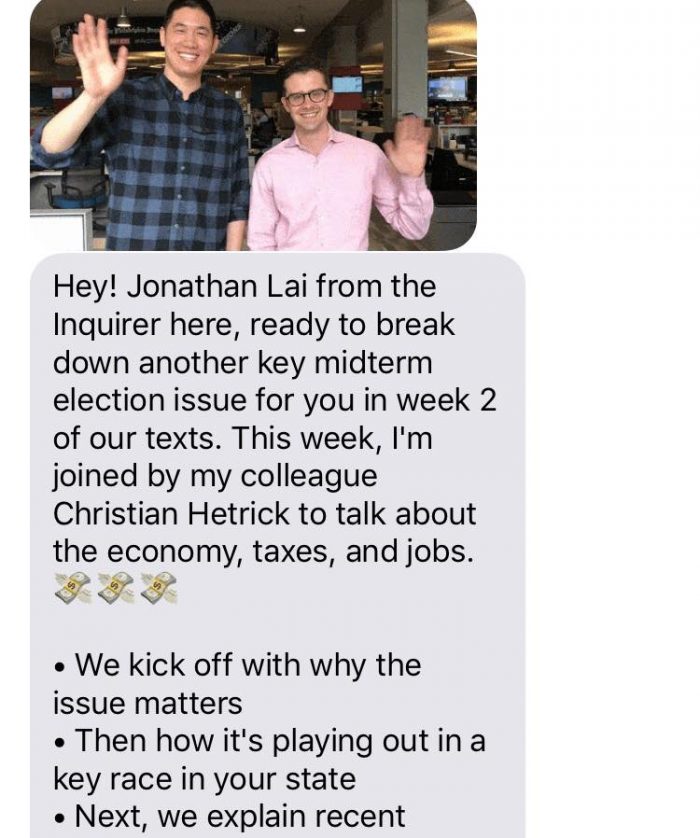
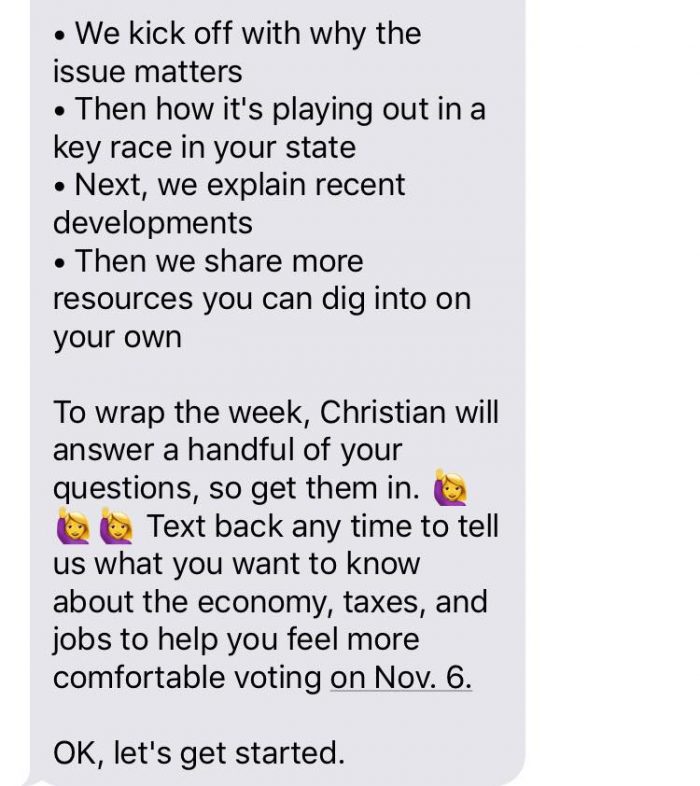
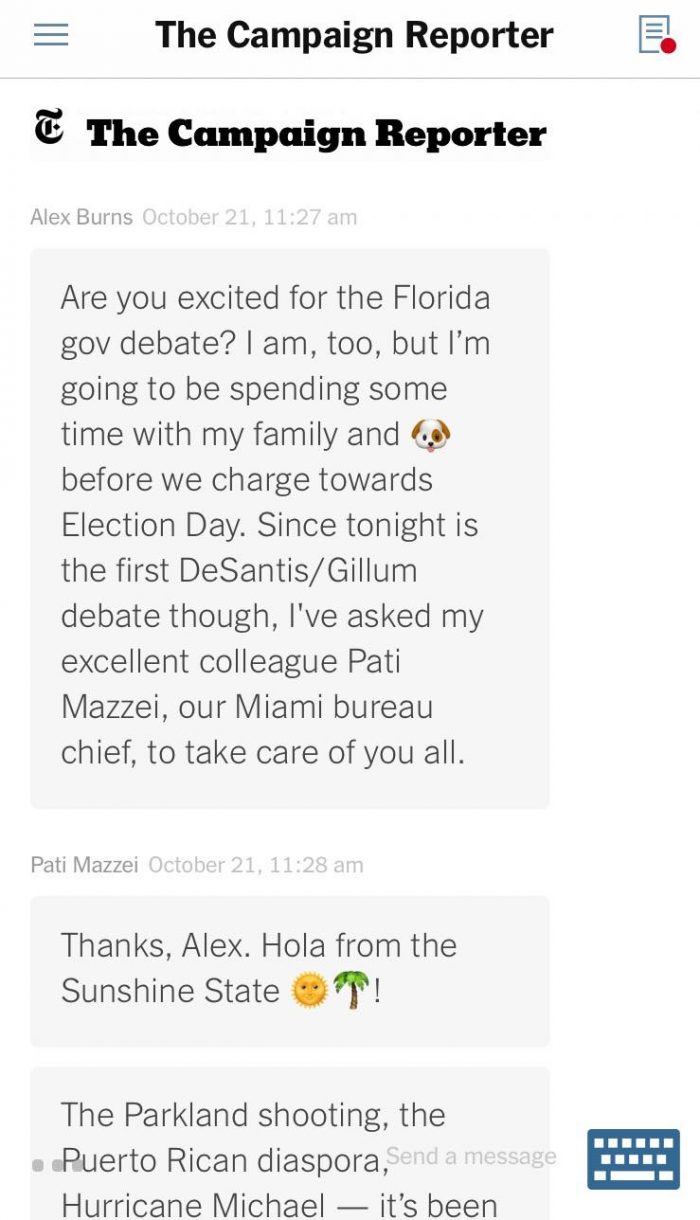
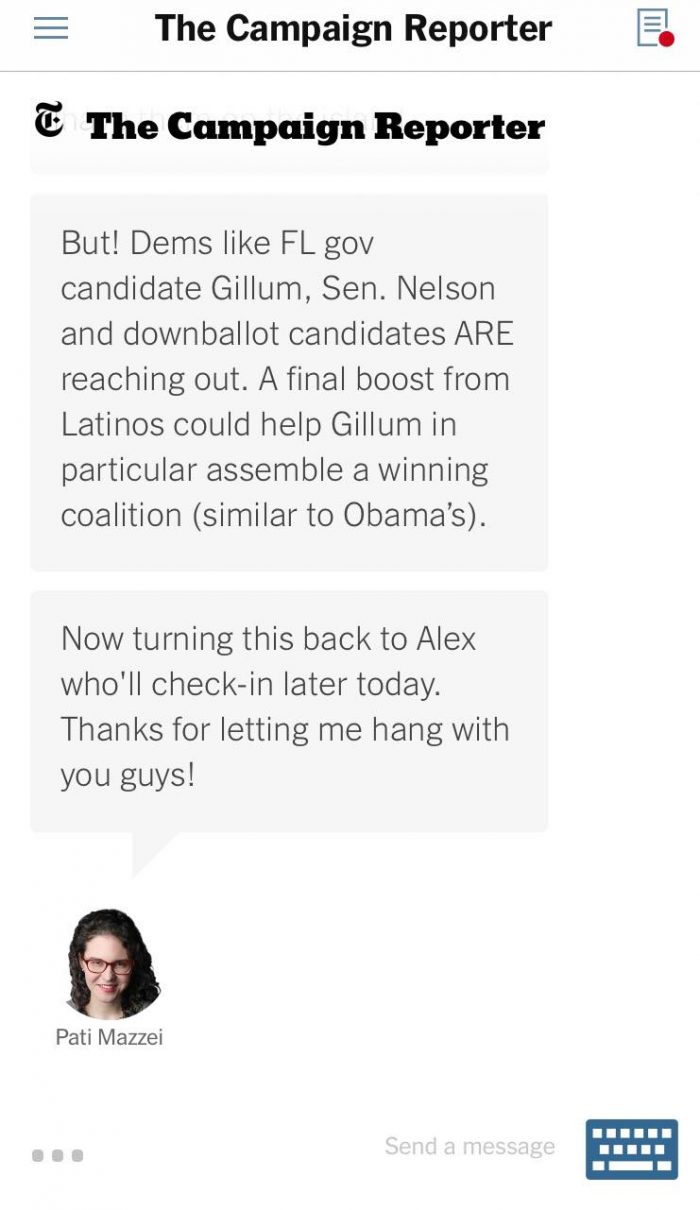
USA Today also recently introduced an elections chatbot on its apps and desktop, leveraging its national network of local outlets.
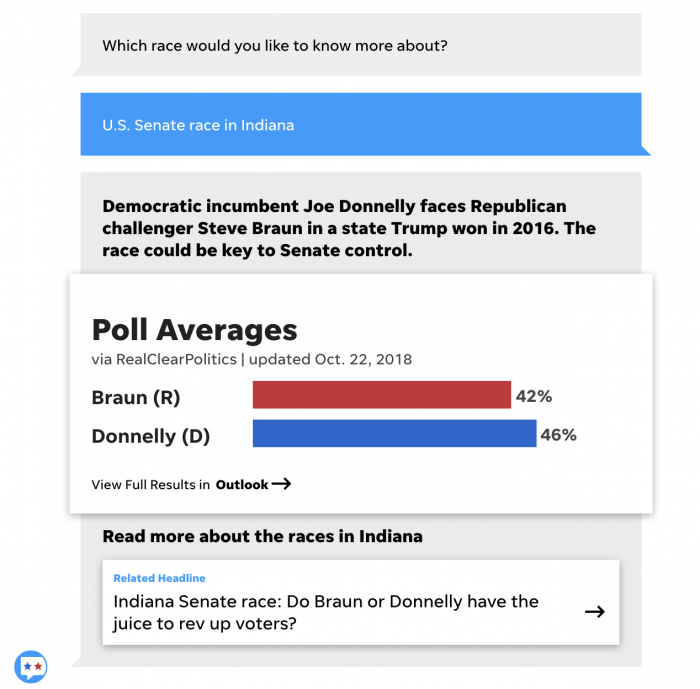
In brief (edited/condensed by me):
- The Times’ audio team isn’t producing a special standalone series for the elections again — hat tip to The Run Up — opting instead to funnel its midterm coverage purely through The Daily.
- NPR’s politics podcast team is tentatively planning to drop several special episodes in the lead-up to the midterms, particularly in the week of the elections itself. That team is already well engaged in a broadcast crossover called The Politics Show from NPR. Meanwhile, expect election-themed episodes from Hidden Brain and It’s Been a Minute, along with a timely investigation from Embedded on a ballot initiative that could restore voting rights for 1.5 million felons in the state of Florida.
- StoryCorps will kick off an initiative called “One Small Step,” which “seeks to help people with opposing political views who don’t know each other have civil, personal conversations.”
- Slate “see[s] the midterms as a play for audience development,” senior producer T.J. Raphael said, with special projects ranging from a partnership with Glamour magazine, Slate Political Gabfest hosting David Axelrod in a special episode, its tech podcast producing an episode focused on what social media companies have been doing in the wake of the 2016 presidential election, and a live show staged in Brooklyn on the Friday after the midterms.
- Vox Media’s Podcast Network is featuring special guests on its podcasts like Hillary Rodham Clinton and Los Angeles mayor Eric Garcetti on Recode Decode and Rebecca Traister and Nate Silver on The Ezra Klein Show, and Today, Explained and The Weeds producing special episodes on electoral strategies and midterm policies.
Voter guides — find your polling place, judges to vote for, etc. — and endorsements are as bread and butter as Cracker Barrel for local outlets. See KPCC/LAist’s Human Voter Guide for a FAQ with some real homo sapiens and using Hearken to add followers’ wonders as well.
Just how curious is the @KPCC @LAist audience?
Through #DearLAist, #HumanVoterGuide, and questions straight to our reporters' @wearehearken embeds, you've sent us 13 questions in the last day, 118 in the last week, and 1,909 in the last year! pic.twitter.com/dComDGuENZ
— Ashley Alvarado (@AshleyAlvarado) October 23, 2018
The Human Voter Guide generated “at least 157 questions since August 2 (half through Hearken, the other half through GroundSource, social media, and in person),” Alvarado tells me.
The Washington Post set up a guide for the most important deadline before Election Day itself: how to register to vote in each state, serving double duty as info about voter suppression and a service about what you need to vote in your state. The New York Times has a ballot-style FAQ interactive about the midterms in general (“Does my vote matter?”).
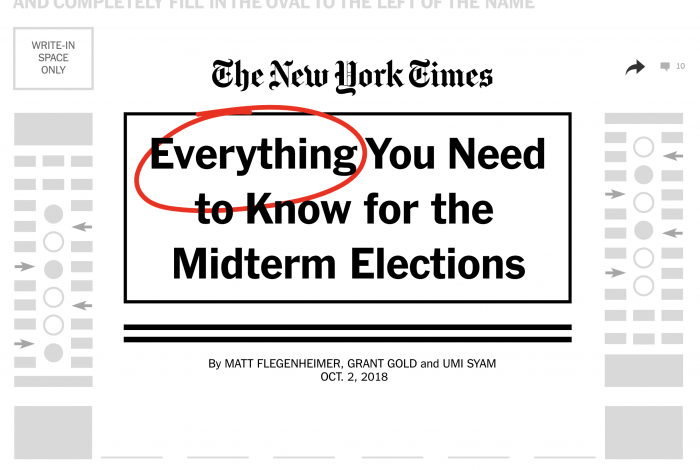
But other media organizations are thinking outside the ballot box: ProPublica and The Skimm are both pushing go-participate-in-your-democracy-goshdarnit efforts.
ProPublica created a User’s Guide to Democracy, an eight-part series sent out to 6,615 newsletter subscribers starting in September with a 30-40 percent open rate. 69 percent of the subscribers were totally new to ProPublica’s database, ProPublica’s PR head Minhee Cho told me, and it’s reaching voters in 433 out of the U.S.’s 435 electoral districts.
The first installment to our User's Guide to Democracy is now live!
Learn how data brokers and social networks use your data to target you for political ads — and sign up for more personalized lessons on how to participate in our democracy: https://t.co/d4IVDMxgCo
— ProPublica (@ProPublica) September 13, 2018
In the 2016 cycle, The Skimm said it registered 95,000 women to vote in its No Excuses non-partisan campaign. (Remember: That race was decided by 80,000-ish voters in swing states.) This year’s revamp comes with a target number of 100,000 people signed up — and actively voting. The Skimm is devoting more resources to this platform this cycle, with a flashy website to see sample ballots and learn about the issues, celebrity partnerships, its first swag for purchase (instead of swag awarded for newsletter referrals) and delegated GOTV captainships among its Skimmbassadors. (Yes, that’s still a word.) At least 40,000 people have committed to voting through the No Excuses platform, and 55,000 people viewed their own sample ballot within 24 hours.

The Post’s Heliograf can formulate stories based on simple data points in repeated story circumstances — like Olympic medal tallies or Mad Libs, one might say. It’s back for the 2018 election “to help tell election stories at the district level, such as details about current office-holders, their challengers, key voter information and the district’s voting history,” according to the Post’s announcement.
We conclude with the aforementioned needle. We’ve written about The New York Times’ decision to show its polling results in real time, phone call by phone call. Maybe the transparency will help ease needle anxiety…maybe not.